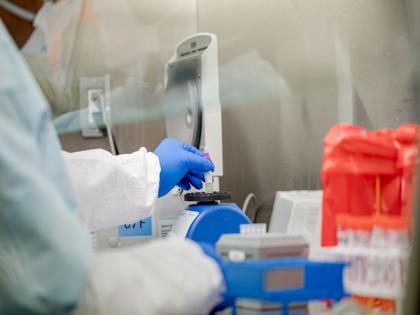Study shows Ferret resistance to SARS-CoV-2 infection
By ANI | Published: April 16, 2021 05:52 AM2021-04-16T05:52:30+5:302021-04-16T06:00:02+5:30
A study of 29 ferrets, which have been shown in laboratory studies to be susceptible to SARS-CoV-2, in a home with constant exposure to two human adults with symptomatic disease, one of whom was confirmed to be infected with SARS-CoV-2, finds no evidence of viral transmission from humans to ferrets; additional genetic sequence analysis suggested that ferrets possess genetic factors that confer resistance to SARS-CoV-2 infection, according to the authors.

Study shows Ferret resistance to SARS-CoV-2 infection
A study of 29 ferrets, which have been shown in laboratory studies to be susceptible to SARS-CoV-2, in a home with constant exposure to two human adults with symptomatic disease, one of whom was confirmed to be infected with SARS-CoV-2, finds no evidence of viral transmission from humans to ferrets; additional genetic sequence analysis suggested that ferrets possess genetic factors that confer resistance to SARS-CoV-2 infection, according to the authors.
Ferrets (Mustela putorius furo) are mustelids of special relevance to laboratory studies of respiratory viruses and have been shown to be susceptible to severe acute respiratory syndrome coronavirus 2 (SARS-CoV-2) infection and onward transmission.
According to the study, 29 ferrets in one home had prolonged, direct contact and constant environmental exposure to two humans with symptomatic disease, one of whom was confirmed positive for SARS-CoV-2.
There was no evidence of SARS-CoV-2 transmission from humans to ferrets based on viral and antibody assays. To better understand this discrepancy in experimental and natural infection in ferrets, we compared SARS-CoV-2 sequences from natural and experimental mustelid infections and identified two surface glycoprotein Spike (S) mutations associated with mustelids. While we found evidence that angiotensin-converting enzyme II provides a weak host barrier, one mutation only seen in ferrets is located in the novel S1/S2 cleavage site and is computationally predicted to decrease furin cleavage efficiency.
These data support the idea that host factors interacting with the novel S1/S2 cleavage site may be a barrier in ferret SARS-CoV-2 susceptibility and that domestic ferrets are at low risk of natural infection from currently circulating SARS-CoV-2. We propose two mechstically grounded hypotheses for mustelid host adaptation of SARS-CoV-2, with possible effects that require additional investigation.
It is not yet known whether natural infection of mals plays a role in public health epidemiology or has the potential to establish endemic reservoirs and threaten wildlife. SARS-CoV-2 has been observed to be capable of natural human-to-mal reverse zoonoses, transmitting from infected individuals into mink, dogs and felines.
The study observed household data support the idea that there may be important barriers to natural infection in ferrets; however, ferrets have been shown to be susceptible to infection and onward transmission in experimental laboratory infections.
To further investigate this, the available genomic sequences of SARS-CoV-2 viruses of naturally infected American minks and experimentally infected ferrets (32 sequences representing 24 mals, accessed 1 August 2020) were analysed. There are viral sequences available from two natural reverse zoonotic events in mink farms in Europe, which allowed us to infer founder-effect mutations versus acquired mutations of relevance to spillover.
The results suggest that virus and host genetic barriers significantly limit natural infection in ferrets, and these are only likely to be overcome by a concentrated and/or diverse inoculum of human-derived virus.
To date, successful experimental ferret infections have used 3 x 105 to 6 x 105 50 per cent tissue culture infectious dose (TCID50) virus, and at least one inoculum contained a minority of virus with the N501T and S686G variants (18, 19). These limitations and putative host adaptations may negatively affect ferrets as a disease or transmission model and should be further investigated.
The data presented here remind us that synthesis of data from surveillance work, natural experiments, and controlled, laboratory-led studies can lead us to novel hypotheses and investigations and allow us to better respond to this pandemic and prepare for the next. This household provides evidence that human-to-ferret SARS-CoV-2 transmission in domestic settings may be lower risk than would be expected from laboratory experiments.
( With inputs from ANI )
Disclaimer: This post has been auto-published from an agency feed without any modifications to the text and has not been reviewed by an editor
Open in app